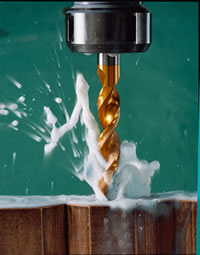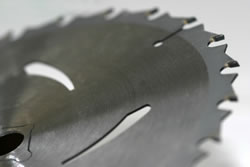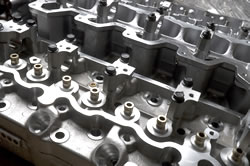Tungsten in High Speed Steels

When tool steels contain a combination of more than 7 % tungsten, molybdenum and vanadium, along with more than 0.60% carbon, they are referred to as high speed steels (HSS).
This term is descriptive of their ability to cut metals at the "high speeds" in use through the 1940’s.
The T-1 type with 18% W has not changed its composition since 1910 and was the main type used up to 1940, when substitution by molybdenum took place. Nowadays, only 5-10% of the HSS in Europe is of this type and only 2% in the USA.
The addition of about 10% of tungsten and molybdenum in total maximises efficiently the hardness and toughness of high speed steels and maintains these properties at the high temperatures generated when cutting metals.
The main use of high speed steels continues to be in the manufacture of various cutting tools: drills, taps, milling cutters, gear cutters, saw blades, etc., although usage for punches and dies is increasing.
| Typical compositions of selected High Speed Steels (%) | ||||||
| Grade | C | Cr | Mo | W | V | Co |
| T-1 | 0.75 | - | - | 18.0 | 1.1 | - |
| M-2 | 0.95 | 4.2 | 5.0 | 6.0 | 2.0 | - |
| M-7 | 1.00 | 3.8 | 8.7 | 1.6 | 2.0 | - |
| M-42 | 1.10 | 3.8 | 9.5 | 1.5 | 1.2 | 8.0 |
 In 1979, the Western World’s production of HSS reached 120,000 tons/year, which has never been achieved again. The production in 1996 was 70,000 tons. One important reason for this is the world-wide rapid spread of coating techniques like the PVD procedure, e.g. the coating of HSS tools with a thin layer of TiN and other types of coating.
In 1979, the Western World’s production of HSS reached 120,000 tons/year, which has never been achieved again. The production in 1996 was 70,000 tons. One important reason for this is the world-wide rapid spread of coating techniques like the PVD procedure, e.g. the coating of HSS tools with a thin layer of TiN and other types of coating.
Coating increases the life of drills by up to 10 times, or it enables the cutting speed (productivity) to be doubled while the lifetime remains the same as for uncoated.
Another reason for declining consumption in HSS is the increasing switch-over to cemented carbide tools.
Heat Resisting Steel
 In certain cases, where corrosion resistant steels are used in higher temperature ranges, tungsten is added. Heat resisting steels are chromium/nickel steels with up to 6% tungsten. The main use is as valve steels for combustion engines, containing around 2% W. Such steels are, for instance, used for the valves on the outlet side of automotive engines, where the red-hot hardness has to be combined with high temperature corrosion resistance.
In certain cases, where corrosion resistant steels are used in higher temperature ranges, tungsten is added. Heat resisting steels are chromium/nickel steels with up to 6% tungsten. The main use is as valve steels for combustion engines, containing around 2% W. Such steels are, for instance, used for the valves on the outlet side of automotive engines, where the red-hot hardness has to be combined with high temperature corrosion resistance.






 sales@chinatungsten.com
sales@chinatungsten.com